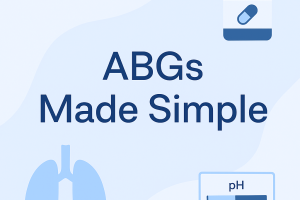Mastering Acute Kidney Injury (AKI) for the NCLEX Exam

Acute kidney injury (AKI) is a critical topic for the NCLEX exam, as it involves understanding the sudden loss of kidney function and its impact on fluid and electrolyte balance. This blog post provides a comprehensive guide to help you prepare for the NCLEX exam by covering the pathophysiology, symptoms, diagnosis, and management of AKI, along with sample NCLEX questions.
What is Acute Kidney Injury?
Acute kidney injury (AKI), formerly known as acute renal failure, is a sudden decline in kidney function that occurs over hours to days. This condition leads to the accumulation of waste products in the blood, electrolyte imbalances, and disturbances in fluid homeostasis.
Pathophysiology
AKI is characterized by a rapid decrease in glomerular filtration rate (GFR), leading to an inability to maintain electrolyte, fluid, and acid-base balance. AKI can be classified into three types based on the location of the injury:
- Prerenal AKI: Caused by decreased blood flow to the kidneys, leading to hypoperfusion.
- Intrinsic (Intrarenal) AKI: Caused by direct damage to the kidneys, such as glomerulonephritis, acute tubular necrosis, or interstitial nephritis.
- Postrenal AKI: Caused by obstruction of urine flow, leading to increased pressure in the kidneys.
Symptoms
- Oliguria: Decreased urine output (<400 mL/day).
- Anuria: Absence of urine output (rare).
- Edema: Swelling due to fluid retention.
- Fatigue and Weakness: Due to accumulation of waste products.
- Nausea and Vomiting: Resulting from uremia.
- Confusion: Due to electrolyte imbalances and uremic toxins.
- Shortness of Breath: Due to fluid overload and pulmonary edema.
Risk Factors
- Dehydration
- Severe Infection (Sepsis)
- Major Surgery
- Trauma
- Chronic Kidney Disease (CKD)
- Medications: Nephrotoxic drugs (e.g., NSAIDs, certain antibiotics, contrast agents)
- Heart Failure
- Liver Disease
Diagnosis
- Serum Creatinine: Elevated levels indicate reduced kidney function.
- Blood Urea Nitrogen (BUN): Increased levels suggest impaired kidney function.
- Electrolytes: Imbalances such as hyperkalemia, hyponatremia, and metabolic acidosis.
- Urine Output: Monitoring for oliguria or anuria.
- Urinalysis: Presence of protein, blood, or casts in the urine.
- Imaging: Ultrasound or CT scan to detect obstructions or structural abnormalities.
- Biopsy: In some cases, a kidney biopsy may be needed to determine the underlying cause.
Management
Prerenal AKI
- Fluid Resuscitation: Administering IV fluids to improve kidney perfusion.
- Treat Underlying Cause: Managing conditions like sepsis, heart failure, or hypovolemia.
Intrinsic AKI
- Avoid Nephrotoxic Agents: Discontinuing or avoiding medications that can damage the kidneys.
- Supportive Care: Maintaining fluid and electrolyte balance.
- Treat Underlying Condition: Managing conditions like glomerulonephritis or acute tubular necrosis.
Postrenal AKI
- Relieve Obstruction: Using catheters, stents, or surgery to remove or bypass the obstruction.
- Monitor for Infection: Prevent and treat urinary tract infections.
General Management Strategies
- Dialysis: Initiated in severe cases to remove waste products and excess fluid.
- Nutritional Support: Providing adequate nutrition while managing fluid and electrolyte balance.
- Medications: Managing hyperkalemia (e.g., insulin and glucose, calcium gluconate), acidosis (e.g., bicarbonate), and other complications.
- Monitoring: Regular monitoring of vital signs, urine output, and laboratory values.
Complications
- Chronic Kidney Disease (CKD): Progression to long-term kidney damage.
- Electrolyte Imbalances: Hyperkalemia, hyponatremia, and metabolic acidosis.
- Fluid Overload: Leading to pulmonary edema and heart failure.
- Infections: Increased susceptibility to infections due to compromised immune function.
Sample NCLEX Questions
Question 1
A patient is admitted with acute kidney injury (AKI) due to dehydration. Which of the following interventions is the priority?
A. Administering diuretics
B. Restricting fluid intake
C. Initiating fluid resuscitation
D. Preparing the patient for dialysis
Answer: C. Initiating fluid resuscitation
Question 2
A nurse is caring for a patient with acute tubular necrosis (ATN). Which of the following laboratory values is most indicative of AKI?
A. Elevated serum creatinine
B. Decreased blood urea nitrogen (BUN)
C. Low potassium levels
D. Increased hemoglobin
Answer: A. Elevated serum creatinine
Question 3
Which of the following symptoms would the nurse expect to find in a patient with postrenal acute kidney injury (AKI)?
A. Polyuria
B. Hypertension
C. Flank pain
D. Hyperglycemia
Answer: C. Flank pain
Question 4
A patient with AKI has a serum potassium level of 6.5 mEq/L. Which of the following interventions should the nurse anticipate?
A. Administering sodium polystyrene sulfonate
B. Restricting dietary potassium
C. Administering calcium gluconate
D. Increasing fluid intake
Answer: C. Administering calcium gluconate
NCLEX Preparation Tips for AKI
- Understand Pathophysiology: Be clear about how AKI occurs and its underlying mechanisms.
- Memorize Key Symptoms: Recognize the classic symptoms and stages of AKI.
- Diagnostic Tools: Familiarize yourself with the various tests used to diagnose AKI and their significance.
- Management Strategies: Know the management protocols for prerenal, intrinsic, and postrenal AKI.
- Complications: Be aware of potential complications and their interventions.
- Practice Questions: Utilize NCLEX practice questions focused on AKI to reinforce your knowledge and improve your test-taking skills.






